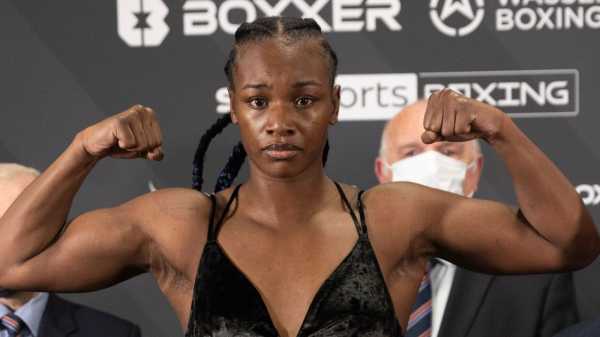
Claressa Shields shone in front of a crowd in awe of a boxing superstar in their presence but promised that her championship belts wouldn’t be lost in the UK.
The sensational American defends her IBF, WBA and WBC middleweight titles against Ema Kozin on Saturday, live on Sky Sports.
Victory would edge her a step closer to fighting WBO champion Savannah Marshall to decide an undisputed ruler in one of the best women’s fights of all time.
- Fit and firing Chris Eubank Jr warns: Words won’t change anything
- Claressa Shields: I’m as good as the best male fighters
Shields wore her red fluffy slippers on stage on Friday night and roared to the crowd as she flexed her muscles.
“It’s go time,” she said. “I’ve been nice this whole time. I have respect for Ema – she’s got more knockouts than I have fights.
Trending
- Transfer Centre LIVE! Lingard, Militao, Osimhen latest
- Conte: Strange so many players left in Jan | ‘Past mistakes made’
- Eubank Jr-Williams in red-hot face-off ‘I’ll smash him’
- Merson Says: Man Utd must get Rice | How would he fit at Old Trafford?
- Morris to Boro: Let Derby move on and take me to court instead
- News: Keane coy on Sunderland job | ‘Let’s see what takes shape’
- Klopp ‘excited’ by Diaz | Liverpool ‘crazy’ to drop Carvalho interest
- Haas kickstart new F1 era with first look at 2022 car
- Rangnick: Lingard asked for time off | Jesse: My headspace is clear
- Shields shows star appeal and vows: ‘Don’t blink!’
- Video
- Latest News
“I’ve been on the world stage since I was 16 – I have two Olympic gold, the first was in London.
“I’m not letting anybody take my titles.
Also See:
“As good as Ema is? I’m great.
“Don’t blink tomorrow.
“I am bringing the belts back home to the USA.”

The smile was gone from Caroline Dubois as she went head to head with Vaida Masiokaite ahead of her professional debut
Caroline Dubois, the feted 21-year-old Olympian who idolises Claressa Shields, will make her pro debut against Vaida Masiokaite.
Chris Jenkins, from Wales, will take on former world champion Julius Indongo.

Heavyweight prospect Steve Robinson is in heavyweight action against Shane Gill
Steve Robinson, the fun-loving Geordie with Disney tattoos who is nicknamed ‘USSR’ due to his likeness to Ivan Drago, is in heavyweight action against Shane Gill.

Harlem Eubank was booed by the Welsh fans but says he will win them over on Saturday night
Harlem Eubank, Chris Jr’s cousin, features on the early undercard.

Swedish heavyweight contender Otto Wallin showed his height advantage over Kamil Sokolowski at the head to head
Otto Wallin, who once caused a massive cut on Tyson Fury’s face, can get back in the heavyweight title mix if he beats Kamil Sokolowski.
Samuel Antwi will face Conah Walker.
Sky Sports Boxing schedule
Saturday February 5 in Cardiff
Chris Eubank Jr vs Liam Williams
Claressa Shields vs Ema Kozin – IBF, WBA and WBC middleweight titles
Saturday February 19 in Manchester
Amir Khan vs Kell Brook
Natasha Jonas vs Ewa Piatkowska – WBO super-welterweight title
Frazer Clarke’s pro debut
Saturday February 26 in Glasgow
Josh Taylor vs Jack Catterall – undisputed super-lightweight titles
Nick Campbell vs Jay McFarlane – Scottish heavyweight title
Saturday March 5 in Fresno
Jose Ramirez vs Jose Pedraza
Saturday March 12 in Newcastle
Savannah Marshall vs Femke Hermans – WBO middleweight title
Sunday March 20 in New York
Edgar Berlanga vs Steve Rolls
Keyshawn Davis
Xander Zayas
Sourse: skysports.com